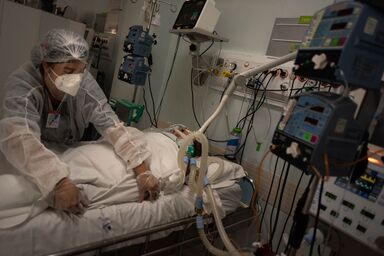Post Intensive Care Syndrome
Introduction[edit | edit source]
As life saving interventions advance, survival of intensive care unit (ICU) patients has improved drastically over the past decades. However, ICU survivors often report long term impairments in physical, cognitive and/or mental health following ICU and hospital discharge [1]
In 2010, the term Post Intensive Care Syndrome (PICS) was created by the Society of Critical Care Medicine. PICS was defined “as new onset or worsening of impairments in physical, cognitive, and or mental health that arose after the ICU and persisted beyond hospital discharge” [1]
Risk factors of PICS[edit | edit source]
A 2020 systematic review and a meta-analysis involving 89 studies identified 60 risk factors for developing PICS. The researchers have identified 3 main health domains: mental health, cognition and physical impairments[2].
Risk factors for mental health[edit | edit source]
The data suggests that females are 237% more likely to suffer from PICS-related mental health problems, whilst a negative ICU experience increased the risk of PICS-related mental health problems by 159%. Interestingly, previous mental health problems increased the risk of PICS-related mental health problems by 845%, proving a great need for appropriate intervention for patients who fall under this category[2].
Risk factors for cognitive impairment[edit | edit source]
The only significant risk factor for cognitive impairment that was identified was delirium[2].
Risk factors for physical impairment[edit | edit source]
The data suggests that older patients appear to have a 119% more likelihood of developing PICS-related physical impairments. Females also have a 96% increased risk of developing PICS-related physical impairments. The most significant risk factor was high disease severity. As the research suggests, patients with high disease severity have a 154% higher chance of developing PICS-related physical impairments[2].
Whilst females appear to be at significant risk factor for 2 out of 3 health domains, the likelihood of developing impairments at more than one health domain was reported to be extremely unlikely, with PICS-related physical impairments being the most common[3].
Does the cause of ICU admission affect the likelihood of PICS?[edit | edit source]
A recent study involving 2,345 ICU patients attempted to divide the patients into 3 subgroups; medical ICU patients, urgent surgical ICU patients, and elective surgical ICU patients[3].
One year post ICU admission the results showed that 58% of the medical ICU patients, 64% of the urgent surgical ICU patients, and 43% of the elective surgical ICU patients were suffering from new physical, mental, and/or cognitive health problems. Most patients were only experiencing problems in a single health domain, with physical problems being the most common[3].
Major differences were found in the occurrences of new post ICU problems amongst the 3 subgroups. Urgent surgical patients appeared to suffer the most, with substantial differences observed when compared to elective surgical patients in frailty (12% vs. 4%), fatigue (45% vs. 24%), muscle weakness (22% vs. 10%), anxiety (20% vs. 9%), and cognitive impairment (13% vs. 6%). Medical patients appeared to have similar but slightly lower numbers than urgent surgical patients[3].
Implications for clinical practice for physiotherapists[edit | edit source]
Physiotherapists as well as the wider multidisciplinary team should to identify those patients who are at increased risk of developing PICS. Physiotherapists are recommended to initiate early mobilisations for all patients, specifically those who are at an increased risk of PICS [3] [4].
A 2018 systematic review and a meta-analysis found that early rehabilitation has been found to significantly improve short term PICS related physical impairments [5].
Physiotherapists are often afraid to initiate early mobilisation in ICU due to a number of barriers such as lack of training and low confidence levels. Yet, some studies have suggested great results from very simple mobility protocols such as short walks twice a day [6].
A 2023 study involving 684 critically ill patients found that daily mobilisations for durations of more than 40 minutes in total were independent predictors of improved functional outcomes on ICU discharge [7]. Indeed more studies are needed to determine whether similar improved functional outcomes can be achieved through daily 40 minutes of non-walking activities such as bed exercises or sitting on the edge of the bed for those unable to mobilise.
References[edit | edit source]
- ↑ 1.0 1.1 Needham DM, Davidson JE, Cohen H, Hopkins RO, Weinert CR, Wunsch H, et al. Improving long-term outcomes after discharge from intensive care unit. Critical Care Medicine [Internet]. 2012 Feb 1;40(2):502–9. Available from: https://doi.org/10.1097/ccm.0b013e318232da75
- ↑ 2.0 2.1 2.2 2.3 Lee M, Kang J, Jeong YJ. Risk factors for post–intensive care syndrome: A systematic review and meta-analysis. Australian Critical Care [Internet]. 2020 May 1;33(3):287–94. Available from: https://doi.org/10.1016/j.aucc.2019.10.004
- ↑ 3.0 3.1 3.2 3.3 3.4 Geense W, Zegers M, Peters M, Ewalds E, Simons KS, Vermeulen H, et al. New Physical, Mental, and Cognitive Problems 1 Year after ICU Admission: A Prospective Multicenter Study. American Journal of Respiratory and Critical Care Medicine [Internet]. 2021 Jun 15;203(12):1512–21. Available from: https://doi.org/10.1164/rccm.202009-3381oc
- ↑ Brown SM, Bose S, Banner‐Goodspeed V, Beesley SJ, Dinglas VD, Hopkins RO, et al. Approaches to Addressing Post–Intensive Care Syndrome among Intensive Care Unit Survivors. A Narrative Review. Annals of the American Thoracic Society [Internet]. 2019 Aug 1;16(8):947–56. Available from: https://doi.org/10.1513/annalsats.201812-913fr
- ↑ Fuke R, Hifumi T, Kondo Y, Hatakeyama J, Takei T, Yamakawa K, et al. Early rehabilitation to prevent postintensive care syndrome in patients with critical illness: a systematic review and meta-analysis. BMJ Open [Internet]. 2018 May 1;8(5):e019998. Available from: https://doi.org/10.1136/bmjopen-2017-019998
- ↑ Brown CJ, Foley KT, Lowman J, MacLennan PA, Razjouyan J, Najafi B, et al. Comparison of posthospitalization function and community mobility in hospital mobility program and usual care patients. JAMA Internal Medicine [Internet]. 2016 Jul 1;176(7):921. Available from: https://doi.org/10.1001/jamainternmed.2016.1870
- ↑ Lorenz M, Fuest K, Ulm B, Grunow JJ, Warner L, Bald A, et al. The optimal dose of mobilisation therapy in the ICU: a prospective cohort study. Journal of Intensive Care [Internet]. 2023 Nov 20;11(1). Available from: https://doi.org/10.1186/s40560-023-00703-1







